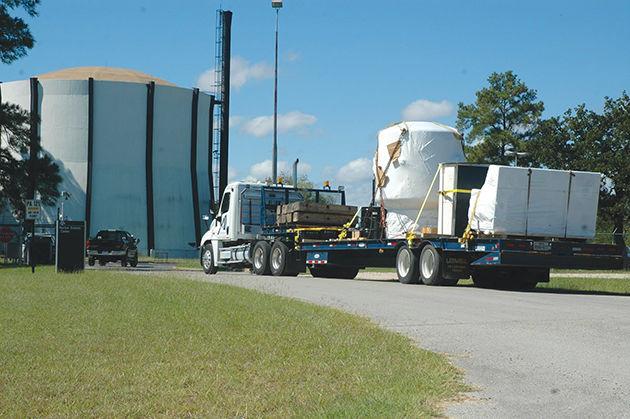After two years of planning, A&M securely moved a 60-year-old device located in the basement of the former Zachry Engineering Building.
Last semester, the AGN-201M reactor — one of A&M’s two nuclear reactors — was relocated from the Zachry Building to the Nuclear Science Center, or NSC. The AGN reactor has been in operation since 1957 and has a power of five watts — one eighth the power of a standard incandescent light bulb. The 1,000,000 watt, or one megawatt, TRIGA reactor was built in 1961 and is currently the only active reactor on campus.
Sean McDeavitt, director of the NSC and professor of nuclear engineering, said the purpose of both reactors is for teaching and research. Students and faculty are able to learn the fundamentals of nuclear reactor operations and interactions of neutrons with matter.
“[The AGN reactor] does all the basic nuclear physics on the nuclear reactor, so we can put students on the control console,” McDeavitt said. “It is excellent for a very simple system, that is ‘impossible’ for anybody to break and is something that can demonstrate nuclear principles … To put the power of the TRIGA reactor into perspective, a commercial reactor that generates electricity for large areas tends to be about of 3,000 megawatts of energy — about 3,000 times bigger than A&M’s TRIGA reactor.”
The fuel for the AGN reactor was moved Oct. 2 of last year and the reactor components were moved almost two weeks later on Oct. 15. N.K. Anand, executive associate dean of engineering, said A&M needed to relocate the AGN nuclear reactor because of the Zachry Building renovation — now renamed the Zachry Engineering Education Complex.
“We are renovating and expanding Zachry, so we needed to move it to a different location,” Anand said. “While the reactor is here, we cannot renovate and do the expansion in and around that area. So we need to go through a special process to make sure there is no residual radiation in its current location and the reactor is safely transported to its new location.”
The AGN reactor is currently offline. The radioactive material is separated from the reactor components and is stored in the NSC with strict regulations by the Nuclear Regulatory Commission. James Massey, AGN reactor relocation project manager, said the relocation of the AGN reactor was originally kept quiet to maintain maximum safety and make sure all the rules were followed.
“The whole process was one that we wanted to make sure was accomplished very safely,” Massey said. “As you can imagine, from a reputational standpoint, a safety standpoint and from just an exposure standpoint, there is a lot of risk that is involved. There were safety element requirements that we had to make sure that things were encased and insulated and would not spill.”
Since A&M does not plan to move the AGN reactor again, they will make the Nuclear Science Center the home of the AGN and TRIGA reactors. Anand said with the flow of more students in Zachry next year, the new home for the reactor is better for researchers.
“The Zachry renovation and expansion is to accommodate undergraduate education in engineering,” Anand said. “So we are going to be [building] nine undergrad common laboratories, so there will be a lot of traffic, it will benefit less number of students. This one will only benefit nuclear engineering undergraduate students. There is no need to put it in a common facility.”
While A&M does not plan to increase the power of the AGN reactor, they are planning to increase the TRIGA reactor from one megawatt to 1.25 megawatts to generate a higher production rate.
The research done on the nuclear reactor ranges from biological research, isotope production, neutrino research and radioactive decay. For students and faculty members, research projects underway can range in length from a few days to a few years and can operate simultaneously.
“We recently had a student from the Vet Medicine School irradiating salmonella and looking at radiation as a way to control salmonella,” McDeavitt said. “We have a group from physics right now who are developing a neutrino detection — really small tiny nuclear particle with high intensity nuclear physics … We have done exposure of advanced materials, we have done exposure of advanced detection systems or electronics systems — it just becomes a matter of what the development purpose is.”
Isotopes are commonly used in many fields as radioactive tracers, including for heart-induced stress tests, refinery leak checking, oil fracking and more. McDeavitt said A&M can produce many isotopes and can distribute them to other companies.
“We ship somewhere between 300 to 500 isotope shipments a year,” McDeavitt said. “Radioactive isotopes have roles to play in medical facility, and [many] medical procedures involve some form of radioactive isotopes which have to be produced somewhere … There are different areas where radioactive tracers become exceptionally needed and they can be made in nuclear reactors.”
There are different ways to access the TRIGA reactor to perform all types of research. McDeavitt said the NSC is looking to expand its research and selects undergraduate students to work on the reactor every year.
“We are actually seeking to increase our research portfolio,” McDeavitt said. “It’s not too hard to find time on the reactor right now. I am also reaching out to the department of energy and the isotope generation office … One of the things that happens, is we hire undergraduate students from the university every year, usually about a cohort of two and five sophomores. By the time they graduate, they have a reactor operator license.”























